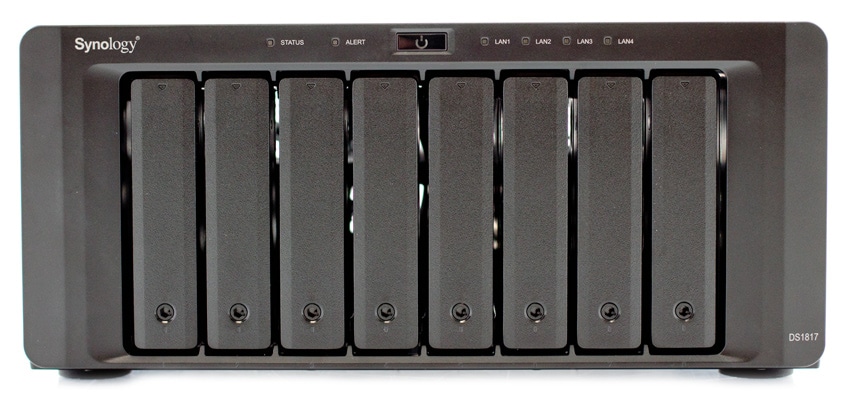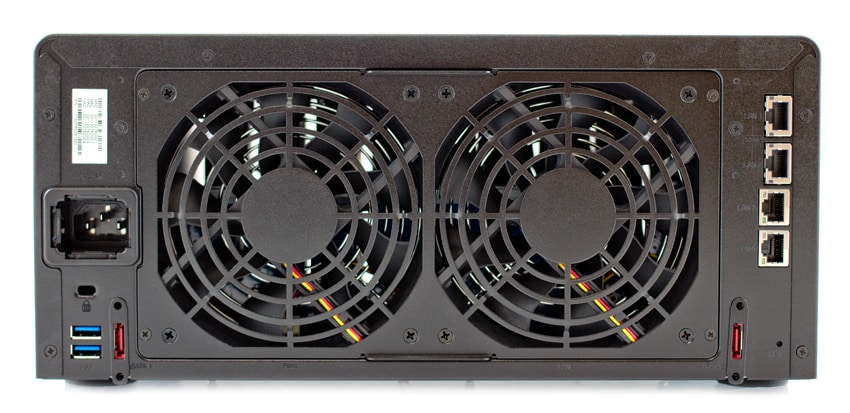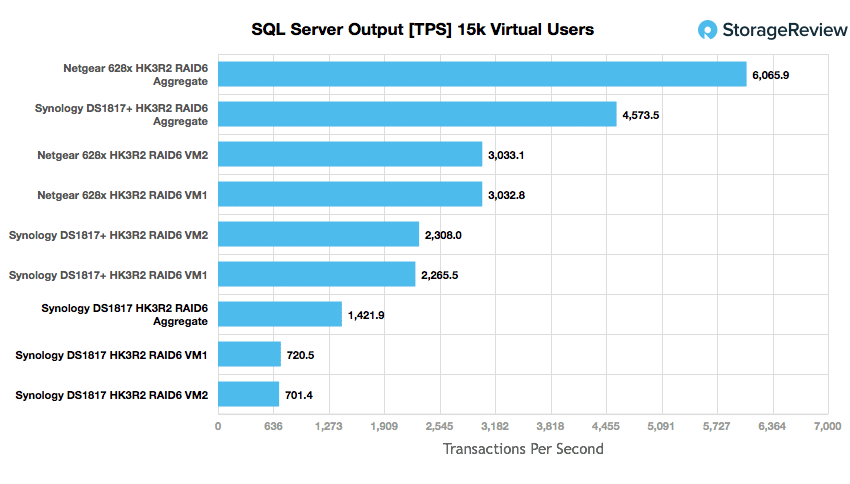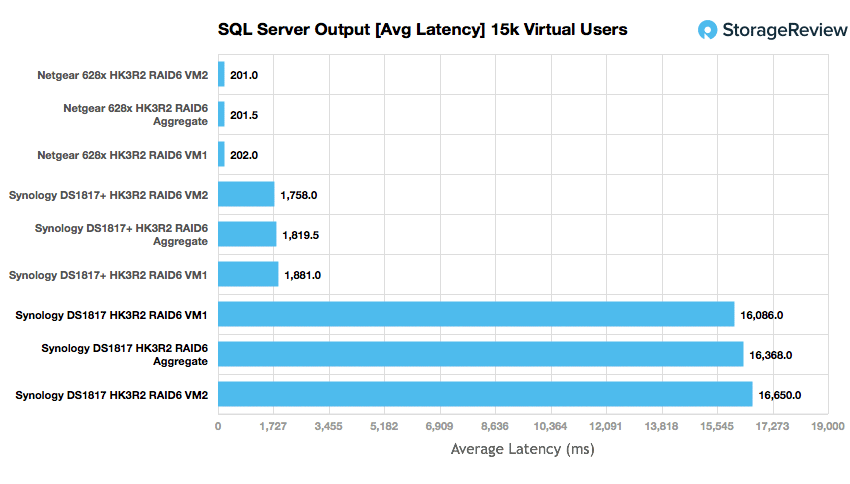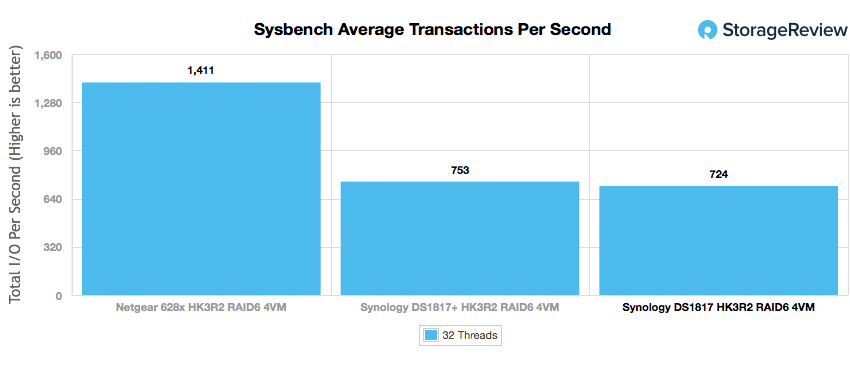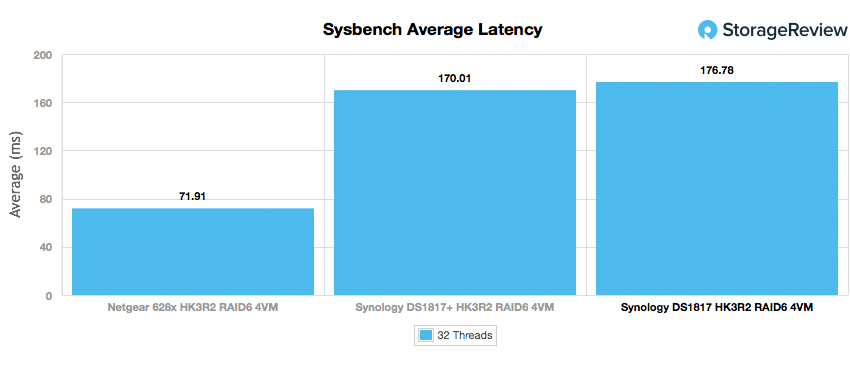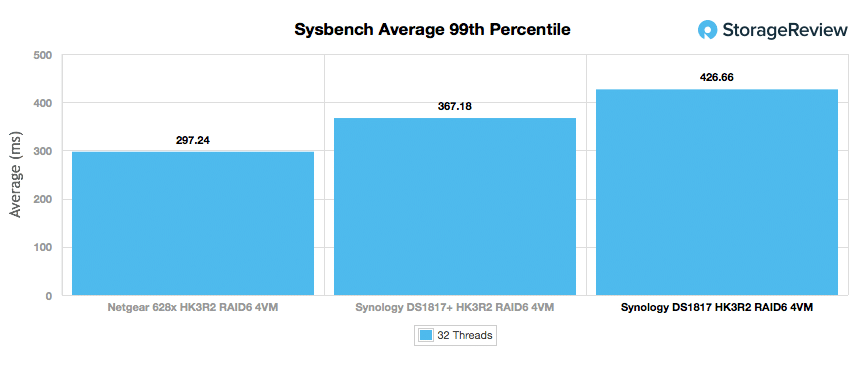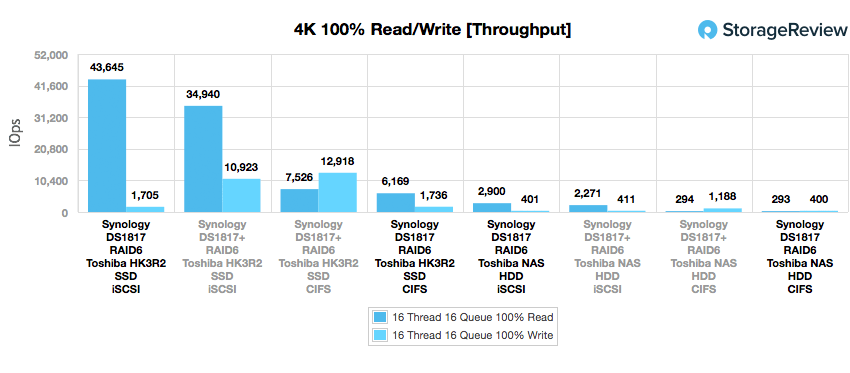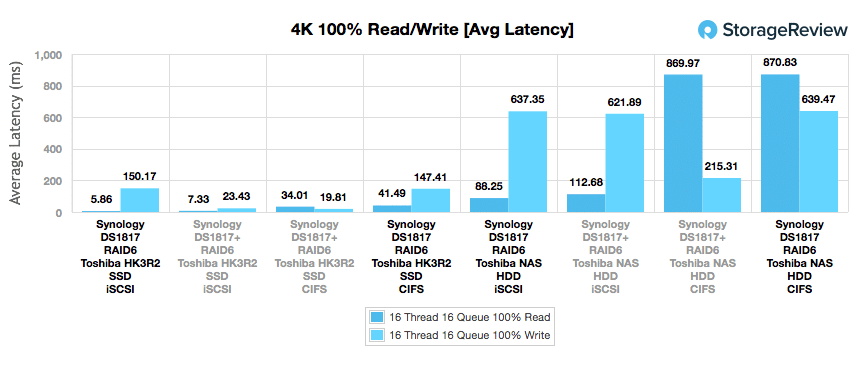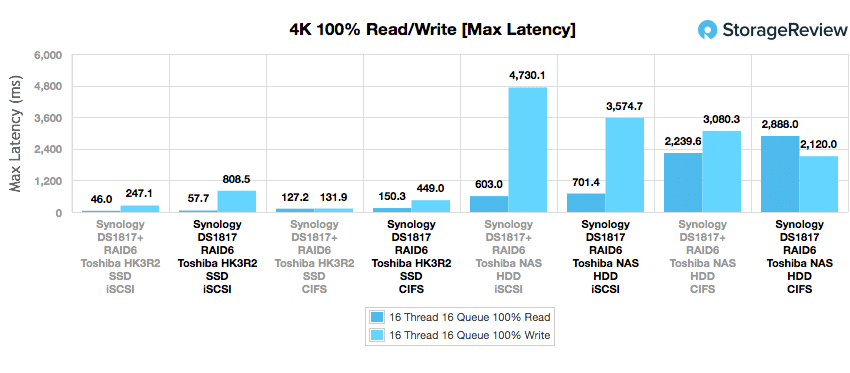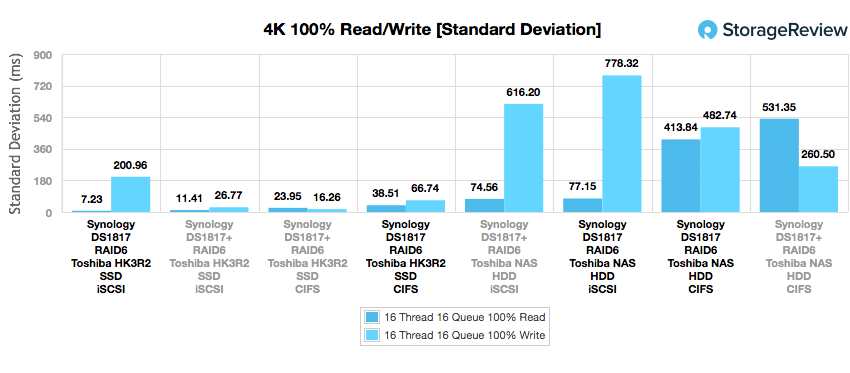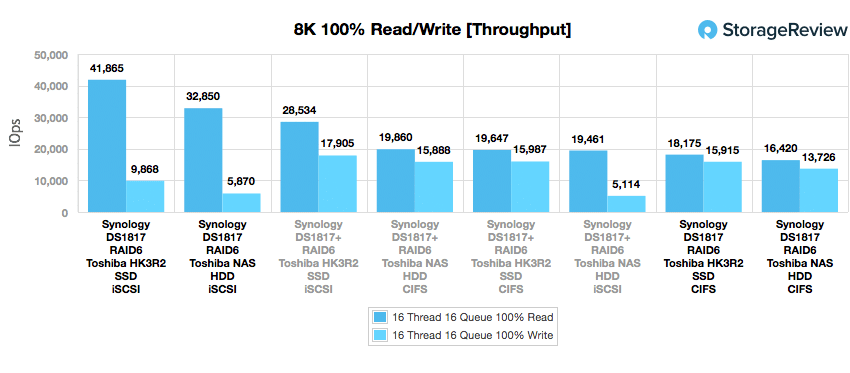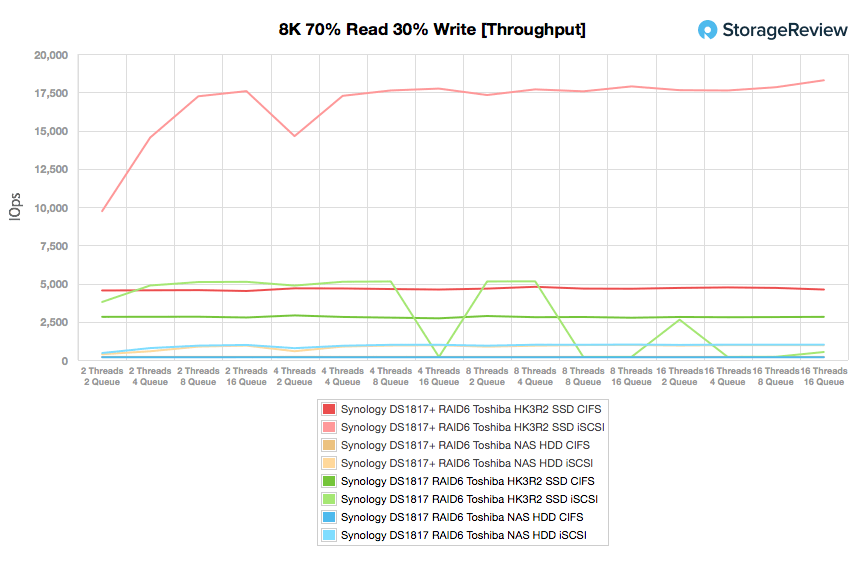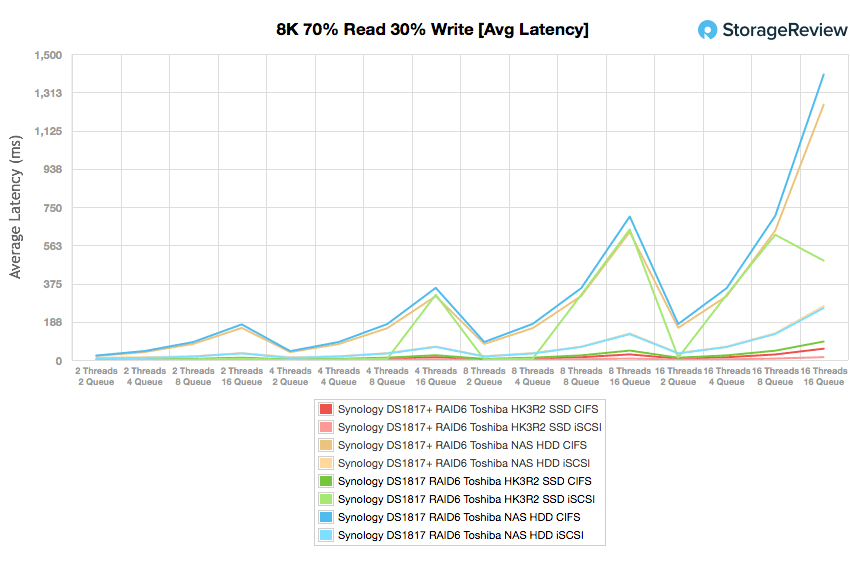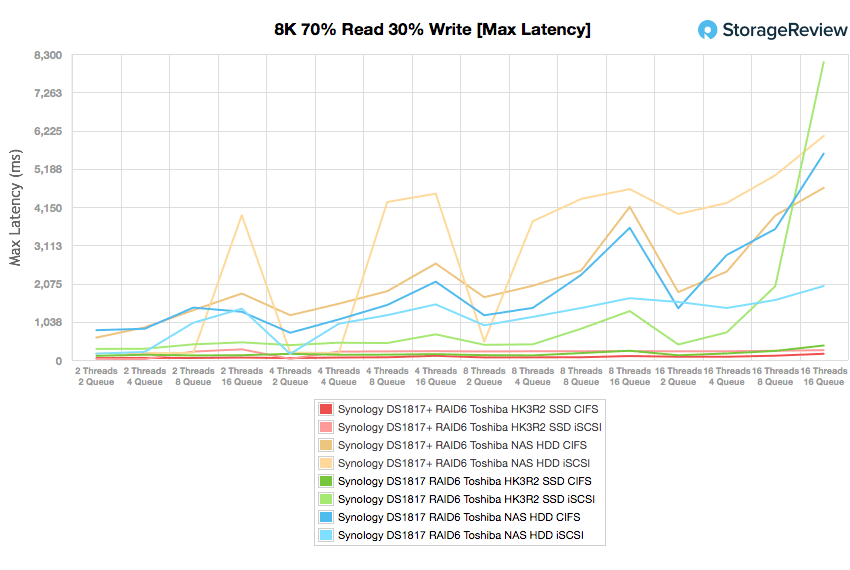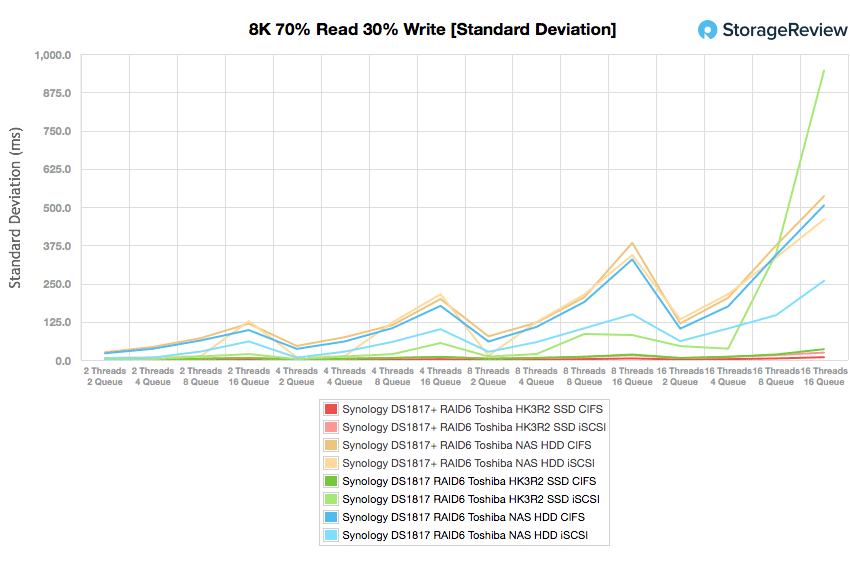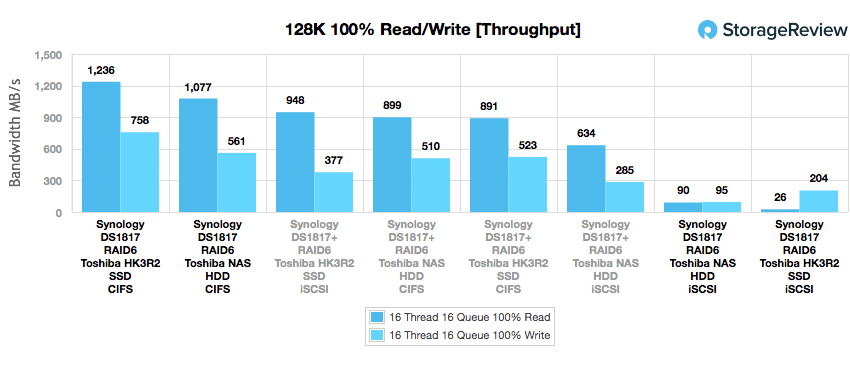
The Synology DiskStation DS1817 is a high capacity, full-featured NAS solution that promises to bring high-end functionality and performance to the SMB market, all at an affordable price point. Whereas the DS1817+ is optimized for encryption and intensive tasks, the DS1817 is specced to potentially deliver higher data-transfer rates. It comes equipped with built-in, dual 10GbE LAN and dual Gigabit ports, and support for link aggregation and failover functions. Moreover, with its 8-bay configuration, the DS1817 is a very scalable device as it supports a maximum of 18 drives using two DX517 Synology expansion units for a whopping total of 216TB via 12TB drives.
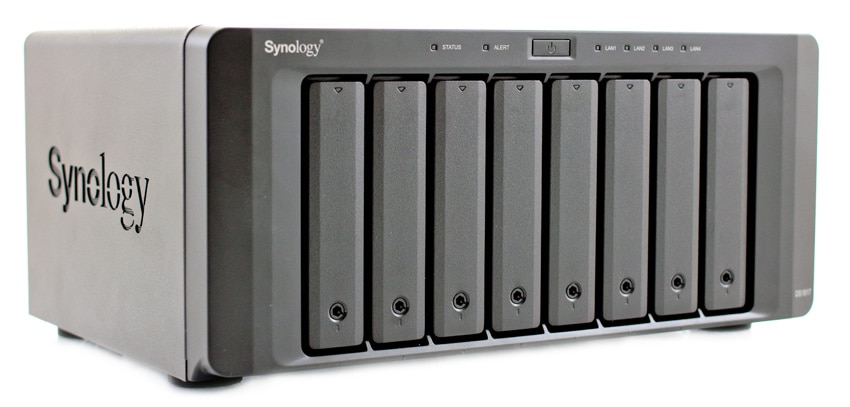
The DS1817 is powered by a Quad-core 1.7GHz CPU (Annapurna Labs Alpine AL-314) and features up to 8GB of DDR3L RAM (4GB standard). With this hardware, the 8-bay Synology NAS is quoted to deliver a maximum of 1,577MB/s in sequential reads, which is roughly 400MB/s faster than the plus model.
Like all Synology NAS solutions, the DS1817 is managed by the comprehensive DSM operating system. Users will be able to take advantage of software like the Cloud Station Suite, which offers real-time data synchronization across all devices (including other Synology NAS solutions) when editing or adding files. Synology uses "intelliversioning" to ensure that the most important file versions are used, which helps to optimize storage space. Users will also be able to leverage the web-based, fast and secure management tool File Station, which features easy, drag-and-drop operation and without any complicated setup process. In addition, its advanced search and filtering capabilities mean more efficient organization and sharing of files.
Available as a diskless model for roughly $840, the DS1817 is covered by an 3-year limited warranty.
Synology DiskStation DS1817 Specifications
- CPU
- CPU Model: Annapurna Labs Alpine AL-314
- CPU Architecture: 32-bit
- CPU Frequency: Quad Core 1.7 GHz
- Hardware Encryption Engine
- Memory:
- System Memory: 4 GB DDR3L
- Memory Module: Pre-installed 4GB (1 x 4GB)
- Total Memory Slots: 2
- Memory Expandable up to: 8 GB (4GB x 2)
- Storage
- Drive Bays: 8
- Maximum Drive Bays with Expansion Unit: 18
- Compatible Drive Type:
- 3.5" SATA HDD
- 2.5" SATA HDD
- 2.5" SATA SSD
- Maximum Internal Raw Capacity: 96 TB (12 TB drive x 8) (Capacity may vary by RAID types)
- Maximum Raw Capacity with Expansion Units: 216 TB (12 TB drive x 18) (Capacity may vary by RAID types)
- Maximum Single Volume Size: 108 TB
- Hot Swappable Drive
- External Ports
- RJ-45 1GbE LAN Port: 2 (with Link Aggregation / Failover support)
- RJ-45 10GbE LAN Port: 2 (with Link Aggregation / Failover support)
- USB 3.0 Ports: 2
- eSATA Ports: 2
- File System:
- Internal Drives: EXT4
- External Drives:
- EXT4
- EXT3
- FAT
- NTFS
- HFS+
- exFAT
- Appearance:
- Size (Height x Width x Depth): 157 mm x 340 mm x 233 mm
- Weight: 5.31 kg
- Others:
- System Fan: 120 mm x 120 mm x 2 pcs
- Fan Speed Mode
- Cool Mode
- Quiet Mode
- Easy Replacement System Fan
- Power Recovery
- Noise Level: 24.2 dB(A)
- Power
- Scheduled Power On/Off
- Wake on LAN/WAN
- Power Supply Unit / Adapter: 250W
- AC Input Power Voltage : 100V to 240V AC
- Power Frequency: 50/60 Hz, Single Phase
- Power Consumption:
- 59.1 W (Access)
- 26.4 W (HDD Hibernation)
- Environment Temperature
- Operating Temperature: 5°C to 40°C (40°F to 104°F)
- Storage Temperature: -20°C to 60°C (-5°F to 140°F)
- Relative Humidity: 5% to 95% RH
- Warranty: 3-year Limited
Design and Build
At first glance, the DS1817 looks identical to the plus version with the usual matt-black plastic enclosure; however, there are small differences. Unlike the plus model, the DS1817 does not have a USB port on the front panel and it has a noticeably smaller bezel underneath the 8 drive bays. Along the top are the LED lights, which surround the power button. This includes the Status and Alert indicators, which gives information about the status of the NAS and warnings related to fan or temperature, respectively, and the LAN indicators, which display the status of the network connection. Each drive-bay has an individual drive lock and status indicator. You can access drives by pressing the lower part of the tray and pulling out the handle.
Like all Synology devices of this class, the Synology logo on the sides of the device act as ventilation. RAM is accessed through the bottom of the NAS. Simply remove the four screws to open up the bottom panel.
Turning the NAS around will reveal the dual fans (4.72” x 4.72”); if one of then malfunctions, a loud beeping noise will sound. Located at the bottom left are the power port, two USB 3.0 ports, and the Kensington Security Slot, while an eSATA port are located on either side of the DS1817.On the right are two 10GbE RJ-45 ports, two 1GbE RJ-45 ports and a reset button.
Testing Background and Comparables
The Synology DS1817 will be compared two other 8-bay NAS units, including the Synology DS1817+ and the NETGEAR 628X. We tested the DS1817 in RAID6 and used both SSDs and HDDs in both iSCSI and CIFS configurations.
The drives used for this review were:
Application Performance Analysis
SQL Server Performance
Each SQL Server VM is configured with two vDisks: 100GB volume for boot and a 500GB volume for the database and log files. From a system resource perspective, we configured each VM with 16 vCPUs, 64GB of DRAM and leveraged the LSI Logic SAS SCSI controller. While our Sysbench workloads tested previously saturated the platform in both storage I/O and capacity, the SQL test is looking for latency performance.
This test uses SQL Server 2014 running on Windows Server 2012 R2 guest VMs, being stressed by Dell's Benchmark Factory for Databases. While our traditional usage of this benchmark has been to test large 3,000-scale databases on local or shared storage, in this iteration we focus on running out four 1,500-scale databases on the NAS over iSCSI.
SQL Server Testing Configuration (per VM)
- Windows Server 2012 R2
- Storage Footprint: 600GB allocated, 500GB used
- SQL Server 2014
- Database Size: 1,500 scale
- Virtual Client Load: 15,000
- RAM Buffer: 48GB
- Test Length: 3 hours
- 2.5 hours preconditioning
- 30 minutes sample period
SQL Server OLTP Benchmark Factory LoadGen Equipment
- Dell PowerEdge R730 Virtualized SQL 4-node Cluster
- Eight Intel E5-2690 v3 CPUs for 249GHz in cluster (Two per node, 2.6GHz, 12-cores, 30MB Cache)
- 1TB RAM (256GB per node, 16GB x 16 DDR4, 128GB per CPU)
- SD Card Boot (Lexar 16GB)
- 4 x Mellanox ConnectX-3 InfiniBand Adapter (vSwitch for vMotion and VM network)
- 4 x Emulex 16GB dual-port FC HBA
- 4 x Emulex 10GbE dual-port NIC
- VMware ESXi vSphere 6.0 / Enterprise Plus 8-CPU
When looking at SQL Server Output, we tested two SQL VMs each with a 15,000VU load applied. This gave us individual TPS scores ranging from 720.455 to 701.445 in RAID6, while aggregate results came in at 1421.9 TPS. These results were significantly less than the plus model as well as the Netgear 628x.
Next, we looked at the average latency. In this scenario, the Synology DS1817 ranged from 16,086ms to 16,650 ms (RAID6) with an aggregate performance of 16,368ms.
Sysbench Performance
Each Sysbench VM is configured with three vDisks, one for boot (~92GB), one with the pre-built database (~447GB) and the third for the database under test (270GB). From a system resource perspective, we configured each VM with 16 vCPUs, 60GB of DRAM and leveraged the LSI Logic SAS SCSI controller. Load gen systems are Dell R730 servers; we use four in this review.
Dell PowerEdge R730 Virtualized MySQL 4-8 node Cluster
- Eight Intel E5-2690 v3 CPUs for 249GHz in cluster (Two per node, 2.6GHz, 12-cores, 30MB Cache)
- 1TB RAM (256GB per node, 16GB x 16 DDR4, 128GB per CPU)
- SD Card Boot (Lexar 16GB)
- 4 x Emulex 16GB dual-port FC HBA
- 4 x Emulex 10GbE dual-port NIC
- VMware ESXi vSphere 6.0 / Enterprise Plus 8-CPU
Sysbench Testing Configuration (per VM)
- CentOS 6.3 64-bit
- Storage Footprint: 1TB, 800GB used
- Percona XtraDB 5.5.30-rel30.1
- Database Tables: 100
- Database Size: 10,000,000
- Database Threads: 32
- RAM Buffer: 24GB
- Test Length: 3 hours
- 2 hours preconditioning 32 threads
- 1 hour 32 threads
During our sysbench tests, we looked at the DS1817 configured in RAID6 using 4 VMs only where it fell behind again with a TPS score of 724. In comparison, the Netgear 628x and the plus model measured 1,411 TPS and 752.85 TPS, respectively.
In average latency, the DS1817 recorded 176.785 across 4 VMs while the Netgear NAS posted 71.91ms and the plus model posted 170.013ms.
The DS1817 reached a 99th percentile average latency of 426.66ms while the Netgear and plus model showed roughly 297.24ms and 367.18ms, respectively.
Enterprise Synthetic Workload Analysis
Our enterprise hard-drive benchmark process preconditions each drive into steady-state with the same workload the device will be tested with under a heavy load of 16 threads with an outstanding queue of 16 per thread. It is then tested in set intervals in multiple thread/queue depth profiles to show performance under light and heavy usage. Since hard drives reach their rated performance level very quickly, we only graph out the main sections of each test.
Preconditioning and Primary Steady-State Tests:
- Throughput (Read+Write IOPS Aggregate)
- Average Latency (Read+Write Latency Averaged Together)
- Max Latency (Peak Read or Write Latency)
- Latency Standard Deviation (Read+Write Standard Deviation Averaged Together)
Our Enterprise Synthetic Workload Analysis includes four profiles based on real-world tasks. These profiles have been developed to make it easier to compare to our past benchmarks as well as widely-published values such as max 4k read and write speed and 8k 70/30, which is commonly used for enterprise drives.
- 4k
- 100% Read or 100% Write
- 100% 4k
- 8k 70/30
- 70% Read, 30% Write
- 100% 8k
- 128k (Sequential)
- 100% Read or 100% Write
- 100% 128k
In the first of our enterprise workloads, we measured a long sample of random 4k performance with 100% write and 100% read activity to get our main results. Equipped with Toshiba HK3R2 SSDs in RAID6, the DS1817 showed its best performance in iSCSI with a very solid 43,645 IOPS read (though it had an underwhelming 1,705 IOPS in write). In our HDD configuration, it showed 2,900 IOPS and 401 IOPS (iSCSI) in reads and writes, respectively. For the plus model, we saw much slower SSD read performance with 34,940 IOPS read, though it had much fast write activity with 10,923 IOPS (iSCSI).
When looking average latency using a heavy 16T/16Q load the DS1817 recorded its best read performance when configured in iSCSI with 5.864ms, while CIFS had the best write score with 147.41ms.
When looking at the max latency, the DS1817 posted its best performance in an iSCSI block-level configuration with 57.683ms read. Its best write performance was under CIFS SSD configuration, which recorded 449ms. The plus model showed its best performance under iSCSI as well, posting 46.0ms read.
The last part of our series of 4K benchmarks looks at latency consistency via standard deviation. In this scenario, the DS1817 had a leading 7.226ms in reads via the RAID6 Toshiba HK3R2 SSD configuration (iSCSI block-level).
Our next benchmark measures 100% 8K sequential throughput with a 16T/16Q load in 100% read and 100% write operations. Here, the DS1817 delivered 41,865 IOPS under iSCSI while reaching 15915 IOPS in writes under CIFS.
Compared to the fixed 16 thread, 16 queue max workload we performed in the 100% 4k write test, our mixed workload profiles scale the performance across a wide range of thread/queue combinations. In these tests, we span workload intensity from 2 threads and 2 queues up to 16 threads and 16 queues. The best DS1817 configuration was the iSCSI block-level setup, though it only measured 2,820 IOPS by the end of the test.
When looking at 8k 70/30 average response times, the CIFS file-level SSD configuration recorded a range of 1.41ms to 90.74ms.
Our max latency numbers showed its best results (by far) during our file-level storage configurations when using SSDs. Here, the DS1817 showed a range of 113.25ms to 393.71ms. This was still well behind the plus model CIFS/SSD configuration.
Standard deviation was more or less the same, as the RAID6 CIFS SSD configuration recorded its best performance (1.85ms to 35.3ms).
The last Enterprise Synthetic Workload benchmark is our 128K test, which is a large block sequential test that shows the highest sequential transfer speed for a device. In this workload scenario, the clear winner was the DS1817, which posted an impressive 1.24GB/s read and 758MB/s write under the Toshiba HK3R2 SSD CIFS configuration.
Conclusion
Unfortunately, the DS1817 is an underwhelming release from Synology. This is certainly a surprising trend that's been following the company's SMB solutions like the previously reviewed DS1817+, which also took a hit on performance compared to competing models. On the positive side, the DS1817 has a lot to offer, much of which comes standard with the feature-rish DSM OS. Synology has grown the DSM environment into one of the nicest looking in the market, making it very easy to use and set up. On the hardware side, the DS1817 offers on-board 10GbE connectivity via two 10Gbase-T ports, whereas the DS1817+ supports 10G only through an add-on card, which is optional. The main difference though between these two models is the CPU and chipset; the DS1817+ leverages a standard Intel line, whereas the DS1817 uses one from Annapurna Labs. This allows it to offer quite a few on-board hardware elements such as the faster networking interfaces, but performance takes a huge hit.
In our application tests, the DS1817 falls down quickly from the DS1817+ in our SQL Server test. It offers a fraction of the performance of either the DS1817+ or the Netgear 628x, and latency instead of being measured in milliseconds is measured in seconds. In our MySQL Sysbench test the DS1817 matched the pace of the DS1817+, although both units came in well below the Netgear. In our synthetic workloads, the DS1817 was all over the map. There were a few select benchmarks such as 4K random read or 128K sequential transfers where it out-paced the DS1817+, but in other areas it fell nearly flat. iSCSI performance seemed to be the hardest hit, where we saw sequential speeds measure as low as 26MB/s read and 204MB/s write with a RAID6 SSD disk group backing it. Our 8k mixed workload performance over iSCSI showed an interesting picture, where the DS1817 started off near or above 4000 IOPS, but as the load increased it slowed to as low as 199 IOPs. Compared to the DS1817+ which measured as high as 18,000 IOPS in the same test, this is a massive problem for this unit deployed in heavy-workload environments.
Though it has a wonderful interface and performed well enough in a select few of our benchmarks, the DS1817 is an uneven release by Synology in terms of performance. Ultimately we expect more from Synology, especially at this price point.
Sign up for the StorageReview newsletter

